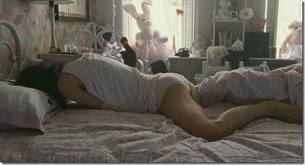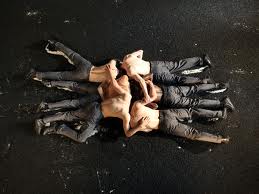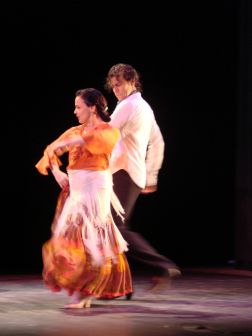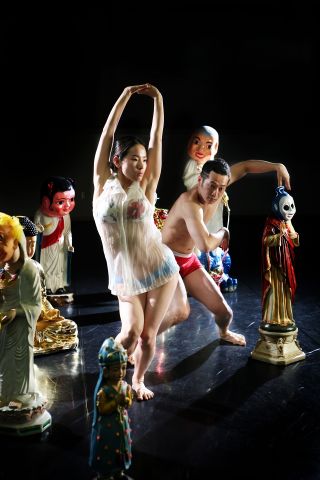By the time I was nine, home was my mother, my sister, and I. We bickered in twos, with the third as chorus and tie breaker. Sometimes my sister would cut me off or my mother her with a complaint about “tone”–how she didn’t “like it.”
It’s a dread phrase, “I don’t like your tone,” because it implies that there isn’t anything behind the tone to have excited it–or that there shouldn’t be.
In the arts, “tone” is the frame the artist gives her subject: quiet, ironic, sincere, dismissive, etc. There is no art without it, but it can be more noticeable in works, like those reviewed here, that are inspired by other works–other dances, movies, books–or that are more dependent on genre identification (thriller, camp horror, etc.) for their effects.
There aren’t many of us dance critics, so it was eye-opening to write on something–the Aronofsky flick Black Swan– reviewed by hundreds. Most of the critics seemed not to notice the punishing wrath that auteur Aronofsky directed at his heroine (the Portman character). The movie evinces no sympathy or even basic respect for her. This isn’t typical of a thriller, in which the thrill depends on us identifying with the victim, not feeling sorry for her.
But critics mainly read the movie as a straight up thriller. Or they made elaborate arguments about its being a camp masterpiece. Only a few, such as Dennis Lim at Slate, allowed that it might be mean and silly simultaneously, the one barring it from camp and the other from being scary. “Aronofsky misses one of camp’s most essential qualities,” Lim writes. “Its tenderness.”
Anyway, here’s a chunk of my Financial Times review:
The only story that movies ever seem to want to tell about ballet is of women destroying themselves for their art: The Red Shoes, in other words. Still, the directors usually have a genuine affection for ballet. Not Darren Aronofsky. The mastermind behind The Wrestler and Requiem for a Dream may offer all the usual accessories to the tale – vengeful ageing divas intent on thwarting the bright young thing headed to her doom, tyrannical directors, ambitious mothers, vicious colleagues, absurdly high stakes – but he forgets to like ballet.
Nina (Natalie Portman) is a soloist in a New York company whose stage door, at least, resembles that of New York City Ballet. The director (Vincent Cassel) offers her the lead in Swan Lake on one condition: that she loosen up. How else can she hope to embody the good Swan Queen’s wicked double, the lascivious Black Swan?
Lose yourself,” the bully exhorts. “Live a little.” He prescribes a regimen of sex – with himself, if she’d like – and masturbation. She takes on the second assignment the way she does everything – with deadly seriousness – in her bedroom, presided over by her stuffed animals.
She does little without supervision, usually supplied by her overbearing, undermining mother (Barbara Hershey).
Nina never can lose herself – there are too many contradictory demands on her. But she does gain a demonic double. Ramming the stuffed animals down the garbage chute, this maniac arrives at the theatre in an orgasmic fury and wins a standing ovation and the director’s ultimate admiration and gratitude for her Black Swan.
It doesn’t ever seem worth it.
The blame lies partly with the constrained camerawork, which never reveals what all the struggle is for. To keep from betraying Portman’s modest training – she devoted a year to a discipline that demands a decade at minimum – the camera stays above the waist. Body double Sarah Lane of American Ballet Theatre provides the precise footwork. We shuttle north to south and back again, with none of the midrange shots of the whole body and expressive face that light up classic dance movies: Gene Kelly singing in the rain, Astaire and Rogers rollerskating in the Park, Moira Shearer pas-de-deuxing with stray newspapers on the vast stage of The Red Shoes.
Worse, though, is the relentless misery to which Aronofsky subjects his heroine. Portman’s face quivers and her eyes brim with tears in almost every scene – even before the balletmaster raises the stakes. When she speaks, her voice barely emerges from her throat, it is so choked with anxiety. Her spine is stiff with fear. In light of her suffering, the thrill leaks out of this thriller. Who cares whether Nina has really sprouted wings or is only going mad? You want the torture to stop.
If Aronofsky had paid some attention to the ballet Nina is destroying herself over, he might have made a less odious film. Sure, there is a good maiden and a sly vixen in Swan Lake, but, like the ballet’s dopey prince, Aronofsky gets them mixed up. The virtuous woman has a self to lose; the schemer merely fakes it.
Odile the Black Swan is easy to understand….
For more on the disconnect between the ballet that the movie alludes to in its very title and the movie itself, click here.
Tone–or sensibility, as Susan Sontag would have it–also counts for a lot in Jack Ferver’s Rumble Ghost, at PS 122, which is abashed by its own irony, a smart and very contemporary POV:
In this startlingly funny mash-up of group psychotherapy and the real-estate thriller Poltergeist, the focus of the horror shifts disconcertingly. Director and actor Jack Ferver uses the methods of experimental theatre to produce this slippery effect.
Rumble Ghost starts with an invented prequel to the 1982 Spielberg movie, about children with special powers and their clueless parents trapped in a ghost-plagued house. Dad Steven (Christian Coulson) and mom Diane (Ferver) are taking a tour of their soon-to-be home. They envision Carole Anne and Robbie’s room here, kids’ bathroom there and Grandma in the basement. Then they envision it again – and again in a dankly hilarious loop. The future is always dimly approaching.
After 20 minutes of scene-setting, “Diane” disappears into “Jack”, the actor playing her. We are now in the present, where the problems are not ghosts but the usual disillusionments: boyfriend not hot enough, artist residency in Paris not cool enough and Jack abashed at his shocking ingratitude.
Instead of Poltergeist’s spiritual medium and paranormal psychologists, we get drama therapy. Chairs are dragged into a circle and the bossy and defensive therapist “director” (Carlye Eckert) corrals four despondent actors – now going by their real names – into taking turns describing their Inner Child. The Inner Child then retaliates by describing his Outer Adult.
Jack Ferver in Inner Child Therapy. Photo by Liz Ligouri.
The childhood memories are puny and fuzzy enough to seem true to life. So are the glib clinical terms by which the performers characterise themselves: they know all the intricacies of the therapists’ diagnostic manual, and they do not believe a word. Their issues have yet to be resolved when the stage goes black.
The circle sitters’ peevishness towards this New Age-style exorcism is funny, but more bitterly funny still is Ferver and his Generation Y cohorts’ devastation at their own chronic irony. Together with Ferver’s understated sureness of touch as director and acting good enough that you hardly notice it, the oscillation between insouciance and desolation makes the show.
In the New York Times, my esteemed colleague Claudia La Rocco asked of Philip Saire’s Lonesome Cowboy,
Do we really need another gloss on the lewd, enraged jock or the primal male whose aggression is barely disguised by a shirt and tie? Mightn’t we move beyond the tired dichotomy of men pushing one another around violently only to end in sexual embraces?
I see what she means. What saved the Joyce show for me was its dispassion, its capacity to observe the moves of homoerotic aggression as if through a telescope from the moon. You may ask, why bother with such socially loaded material if you strip it of its politics, don’t offer insight into its origins or reason for being? Good question! It would have been a better dance if it hadn’t so obviously signaled the social milieu– with suits and ties, and kilts–when its method was mainly inductive, investigating the movement for what it could tell us about the men’s stances toward one another. I was struck by how constant their contact was and how it mattered less that they achieve alpha status than that get a chance to touch and wrangle.
Anyway, here’s a chunk of my Financial Times review:
Swiss choreographer Philippe Saire set the tone for Lonesome Cowboy at curtain’s rise. In midnight-blue, vaguely military, uniforms, five dancers moved through a series of typically male poses. The men flexed their biceps, raised their arms in surrender, crossed those arms over their chests in tight refusal and pulled their elbows towards their stomachs in crushing defeat. But they did all this at the dreamlike pace of t’ai chi.
Like the step-by-step Muybridge photographs of Greco-Roman wrestling that inspired the dance, Lonesome Cowboy approaches an essentially violent subject with cool dispassion. For men’s tendency to threaten, challenge, corral, tease and mangle each other, the choreographer studied the prison gang in Cool Hand Luke and the platoons in Full Metal Jacket, but his tone is less American pistol-packing polemical than Swiss neutral.
Saire offers his dancers’ dodging and feinting, their rolling in each other’s arms across the floor in a rough horizontal waltz, their scuffing up the stage’s black gravel surface in backward lopes, their lifting each other by crotch or nape of neck, without a story. The movement is beautiful. The dancers – all chestnut-haired and of middling height, as if they were brothers – approached the harrowing moves with fearlessness and keen focus. They slid seamlessly between antic violence, erotic tenderness and exhausted collapse. Frozen tableaux emerged from the long bouts of athleticism like sunlight amid a storm.
The transitions from vigour to quiet, which seem inevitable though you don’t anticipate them, account for a good deal of the dance’s pleasure….
For the whole story of Swiss cowboys, click here.
Part I of Pavel Zustiak’s impending trilogy inspired by the Jerzy Kosinski novel The Painted Bird could have easily been too bathetic, too flat, too outraged. You name it. Instead, Zustiak approached the emotional extremity driving the Holocaust tale with tenderness and quiet (as I say below)–uncannily mirroring the novel’s own approach. I’m looking forward to the next two parts, this summer and fall.
Author Jerzy Kosinski may have claimed that as a Jewish child in wartime Poland, he suffered the brutalities detailed in The Painted Bird, but the novel makes other claims. A woman is not merely raped, she has a glass bottle thrust and broken inside her; a man is not simply murdered, he is devoured by hundreds of rats. The novel is an allegory. More than Holocaust atrocities, it conjures the terror of anticipating your extermination: glass breaking inside you. The 1965 book is a pitiless document, told with fairytale simplicity, of a child contending with unfathomable horrors by exiling them from his heart to his imagination.
In the first part of a trilogy inspired by the book – the Baryshnikov Arts Center will present the second in June and PS 122 stages the third in September – choreographer Pavel Zustiak brackets the main event: the boy fingering shards of his shattered memory. The hour-long dance begins with two people and ends with a horde lowering themselves on to their stomachs as if their bones were made of china. Do they lie down because they are weary or because they want to join the boy in his nightmares? Bastard, as the dance is called, is filled with mystery.
When he lives out old memories, the painted bird (Jaro Vinarsky) resembles a cat twitching in its sleep: you can only guess what he is working over.
Brilliant Slovak dancer Jaro Vinarsky. Photo by Megan Green.
The moves themselves are nothing special – they suggest listening, saluting, pelting stones, crawling across ice, and confronting enemies on all sides – but Vinarsky brings to each moment a sense of haunted compulsion…..
For praise of the live music and mention of some flaws that ultimately don’t upset the mood, click here.
At Noche Flamenca’s annual winter show in the Village, Juan Ogalla’s matador lunges and peacock stance drove my friend Haggai crazy. He’s like John Travolta from his disco days, he said.
Until a few years ago the Noche regular annoyed me, too. Too showy, too fussy, I thought. And then, about three years ago, he stopped annoying me. Suddenly I was impressed, excited.
I assumed he had changed, but maybe it was me. Perhaps I finally saw past the flash–or grew inured to it. And which is it? So many variables contribute to what a person hears and sees–and only some of it has to do with the dance itself.
“How do they do that wailing?” my friend exclaimed at the opening of Noche Flamenca’s New York season. He meant without seeming phony. Authenticity is a pressing concern for a populist art form born out of dire circumstances. The small, acclaimed Spanish troupe satisfies this imperative by artfully shaping the dances to pull them into the present tense.
Director Martin Santangelo has organised the 90 minutes of solos, duets and musical interludes to accentuate the shifts in mood. In her increasingly desperate siguiriya, for example, maestra Soledad Barrio circles the stage with trilling feet only to stop dead centre, raise her hands jaggedly overhead as if crushing a clay pot between them, and freeze. A singer immediately begins to moan, carrying the torch of Barrio’s feeling into another idiom.
The transitions between numbers also bleed feeling. In the forthright opener, the three dancers, three singer-percussionists and two guitarists charge toward us in a tight phalanx. As if to intimate that the company is spent, the next number is quiet and ruminative. Under a single spot, guitarist Eugenio Iglesia plucks out a lyrical tune. Likewise, dancer Antonio Jimenez’s dark solea por bulerías – imagine the Tin Woodman in the first throes of lovesickness – evolves slowly in the wake of Soledad Barrio and Juan Ogalla’s suave, flirtatious alegrías.
Barrio and Ogalla. Photo by Marie Daix.
Over the course of the evening, you become keenly aware of the blooming of new feeling and the softening of old: Barrio collapsing forward as if pulling a shroud over her head when the stage goes black at her solo’s end; Ogalla, once all flash and pride, making his arm as luminous as a candle flame, or letting his face go slack and his arms limp so they can absorb the low, fast tremors of his feet.
For more–on Barrio and Ogalla’s “I’m Old-Fashioned” number– click here.
To nail a tone or sensibility is really hard.
And sometimes–for example, at the Japan Society’s Contemporary Dance Showcase this year–the pleasure is that you can’t:
Now that nearly every pocket of the globe has been exposed to view, a foreign experience is harder to come by. In the 14th edition of this annual showcase, Taiwanese, Korean and Japanese choreographers acknowledge our shrunken world, but they also belie it. The four dances cross all sorts of borders while remaining thrillingly untranslatable.
Aptly, the programme’s running theme is how to make sense of an influence, a life, a love or a body that lacks intrinsic logic. Ahn Ae-Soon’s charming “Bul-ssang” – the title is a play on the Korean words for “pity” and “Buddhist statue” – simply lets randomness reign. The piece begins with its eight dancers cradling gaudy plaster of Paris religious statuettes – a serene Buddha, an imploring Jesus. Soon they are breaking into duets and solos that combine hip-hop popping and locking with Kathak stamping and the tiny, shuffling ladies’ steps of traditional Asian dance.
Ahn Ae-soon Dance Company’s Hyo Seon Heo and Hyo In Kim in “Bul-ssang.” Photo © LG Arts Center
Eventually they send stacks of brightly coloured plastic plates flying – building material, it turns out, for a model Buddhist temple they will meticulously construct. Without pointedness, “Bul-ssang” mixes kitsch and art, reverence and insouciance…..
For the rest of the programme–the antic Condors, Maki Morishita’s absurdist domestic drama, and the jellyfish love story from Taiwan– click here.





Nice piece.
Black Swan was lost between the two “camps” as you say and wound up being — just bizarre.
It was very difficult to watch Portman even from the waist up. Oooof!!! Not even a year could have made up for the lack of training.
Sarah Lane is divine and sweet.
Wish I could get some video of The Painted Bird!!!! Didn’t find any audio (?) on the link to the FT.
[apollinaire responds]
Hello, hello!
Thank you so much for your observations. Yes, I think “bizarre” puts the problem with BS precisely. And I found watching Portman even from the waist up painful too: she keeps her shoulders down but, as someone wittily pointed out, seems to have confused herself with a penguin: arms stiff and stumpy.
Oh, I misspoke about what you would find at the other end of “The Painted Bird” link–I had simply meant my description of the music. But here is a link to the downloadable CD of the score: http://christianfrederickson.bandcamp.com/album/the-painted-bird-bastard
I’m not sure how it will sound isolated from the dance–probably a bit industrial for plain listening. But try the track “The Conflicted Body.” I was able to listen to a big chunk of it.
Thanks again for writing ~)
Great recap, and I’m so taken with the second paragraph of the article that I want it tattooed somewhere on my body!
“It’s a dread phrase, ‘I don’t like your tone,’ because it implies that there isn’t anything behind the tone to have excited it–or that there shouldn’t be.”
[Apollinaire responds] hmmmm….where, do you think? maybe somewhere that emits a tone…
Shannon, neat to hear from you!